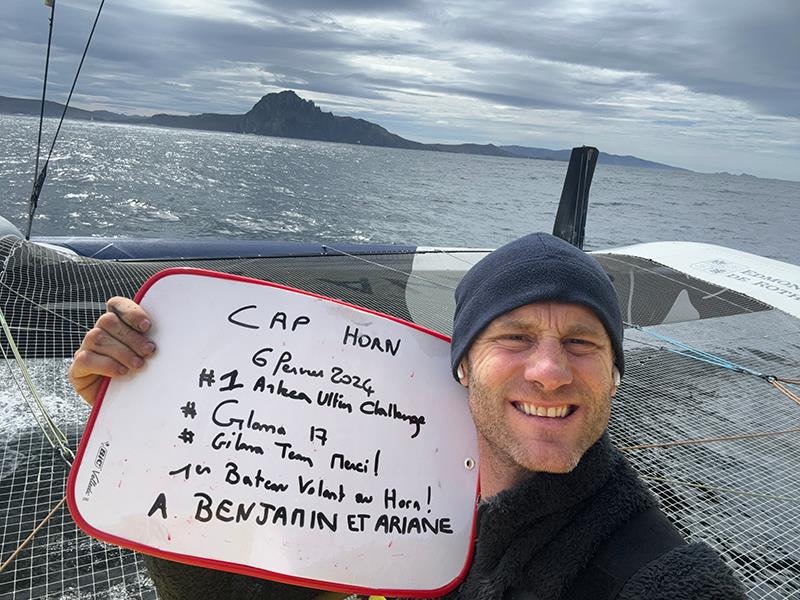
Arkea Ultim Challenge - Brest - Not a very pacific Atlantic
by Gitana Team 8 Feb 2024 22:03 GMT
8 February 2024

Arkea Ultim Challenge - Brest © Charles Caudrelier / GITANA S.A
In the pale light of the austral lands, Charles Caudrelier was able to savour his first single-handed Cape Horn two days ago.
Ahead of the Maxi Edmond de Rothschild, there are still another 6,000 miles to go to transform the magic of this moment into the accomplishment of reaching the finish line. In the meantime, beside the Falklands, the South Atlantic has just thrown up another challenge.
Where major firsts are celebrated
A confetti of rock strewn across the extreme south of Tierra del Fuego, in a narrow corridor separating Chile from the Antarctic peninsula. Tuesday 6 February at 17:08:20 UTC, the Maxi Edmond de Rothschild rounds Cape Horn after 30 days, 4 hours, 38 minutes and 20 seconds of racing, having spent two-thirds of the race at the front of the fleet.
Upon entering the Atlantic Ocean at the head of the Arkea Ultim Challenge, Charles Caudrelier pulls off multiple feats. He treats himself to his first Cape Horn in solo format and treats his boat to the same, thus paying tribute to the visionary spirit of the Gitana Team and its operators, Ariane and Benjamin de Rothschild. He also proves that a flying trimaran of this generation can circumnavigate Antarctica.
The cape is so legendary because, for Charles and all those who have gone before, it represents a welcome epilogue: the exit from the Southern Ocean, from its grey expanses as far as the eye can see, and the end of a sense of vulnerability.
The third and final major cape of a round the world under sail is also the cape most shrouded in myth as it has an historic scent of the great navigators of the 16th and 17th centuries, when the Spanish, Portuguese, then the Dutch, British and French dominated the seas of the globe.
And yet here, there is no sea route to open, no strategic or economic war to wage, it is about sport, technology, human intelligence and setting new targets and challenges for oneself. For the skipper of the Maxi Edmond de Rothschild, this "historic and magical" passage will remain as one of the major milestones in his life as a man and as a sailor.
Pacification
It has not been as simple as all that to get to this stage. Indeed, on 1 February at 20:00 UTC, having racked up four days at an average speed of 30-33 knots in the Pacific, Charles Caudrelier is forced to slow up to avoid plunging with full force into the teeth of an explosive low-pressure system. For more than 48 hours, the blue trimaran barely exceeds 10 knots. It is an unprecedented, strange and ludicrous moment in offshore racing for her skipper who has "never done such a thing ever before" but manages to make the most of this period of calm to go over the boat with a fine-toothed comb.
On 4 February, when he finally fires up again, the sailor is rested and relaxed... especially given the fact that he has lost virtually nothing of his lead over his pursuers prior to his forced stoppage. Two days later, Cape Horn rewards him handsomely with a magnificent passage two miles from the rock, under full main and J2.
A return to a familiar if slightly sensitive area
Charles Caudrelier is now making headway in the decompression chamber that is the South Atlantic. A place where the return to civilisation and the sense of relief often clashes with the reality in the first few days of navigating this region: not easy...
Close-hauled, in a building breeze, the Maxi Edmond de Rothschild is forced to sweep into the Le Maire Strait initially to protect herself from the ice spotted to the north-east of the Isla de los Estados. The presence of icebergs in the vicinity, together with the arrival of a sizeable austral depression map out his strategy for the next stage of the climb up the Atlantic.
"On Wednesday afternoon (7 February), we slowed the boat down for 6 hours to let the worst of the stormy wake of the depression roll through. Next, we had to choose between the plague or cholera," says Benjamin Schwartz, a member of the routing cell for Gitana Team. "To pass to the east of the Falklands, a strategically favourable option, albeit a sensitive one with the potential of ice, or stay inside amidst a myriad of fishing boats." Option No.2 wins out, but Charles spends "a very, very laborious night, in strong wind and atrocious seas, whilst being compelled to keep a visual look-out for fishing boats."
There is a little over 6,000 miles to go before a glimpse of the finish line in this first solo round the world race in ULTIMs. It is a race which Charles Caudrelier has led for 22 days and has every intention of winning.
Ranking on Thursday 8 February at the 20:00 UTC position report:
1/ Maxi Edmond de Rothschild - Charles Caudrelier
2/ Maxi Banque Populaire XI - Armel Le Cleac'h - 2,353.3 miles behind the leader
3/ Sodebo Ultim 3 - Thomas Coville - 2,735.7 miles behind the leader
4/ Actual Ultim 3 - Anthony Marchand - 5,630.8 miles behind the leader
5/ Ultim Adagio - Eric Peron 7,462,2 miles behind the leader
Retired
SVR Lazartigue - Tom Laperche